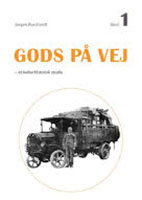
Text from the publisher:
Jørgen Burchardt. Forlaget Kulturbøger 2017. 1,518 p.
In English the title is Goods on roads: Denmark’s road transport history. The history totals 1,500 pages and is divided into three volumes. The first volume tells the story of the first horse-drawn carriages and moves forward to an era in which more than 95% of all cargo was transported on motorized trucks. The technical and infrastructure developments are described in detail, including road transport in connection with rail transport and shipping. The vehicles’ technical developments from small horse-drawn vehicles to today’s reliable, large, and rapid trucks are presented, of course, but the story of the technical facilities of the rest of the infrastructure is also told. Road construction had long been a vulnerable issue, which imposed restrictions on vehicle size, but the development of a gentle low-pressure balloon tire and new road constructions from the 1950s made it possible to repeal many of the restrictions on the use of vehicles. Road transport must be seen in its entire context, that is, in which all parts of the infrastructure change in conjunction with one another. Important elements include the use of standardized pallets, which forklifts use to ensure a rapid transfer between storage and transport.
The second volume shows the transport of different types of supply chains and explains what brings technique to work: organization, collaboration, and governmental regulation. The volume ends with five cases of new transport systems totally transforming industries. The first is about the distribution of the retail trade’s shift from transport based on rail to one based on trucking. The second is about the altered milk collection in agriculture from collection via milk churns to collection via milk tankers. The next case is about the introduction of the first containers in Denmark for bacon exports to England, and another case is similarly about a new mode of transport with prefabricated concrete elements that made it possible to build high-rise buildings and large halls. The last case shows how transport by truck after the 2nd World War made it possible to move industrial and commercial enterprises from narrow locations close to ports and railway stations out to cheaper land, which allowed for a rational layout of production and stocks, with parking for regional mobility and for future expansion.
The third volume contains an overview of Danish and international research and a discussion of the historical development of transport. A continuous theme in the book is the concept of supply chains. A chapter reviews the history of the concept, where it is used in a normative science of managing supply chains, Supply Chain Management. The book also shows, however, that supply chains have always existed. The chains are often very different; each chain has its seasonality, commercial agreements, special transport, etc.
The volume concludes with a detailed subject index, notes, and bibliography. The years 1950 to 1980 are referred to most, as society in those years underwent an economic recovery that will probably never be surpassed. Here, transport plays an important role in the creation of today’s high-tech society. It is due not only to the technical development, but equally to their organizational framework. The book therefore contains several chapters on the establishment of voluntary standards for social regulation and the ongoing regulatory framework, including international agreements. The book’s central view is that the effective high-tech community has been so thoroughly regulated and so complicated that complexity makes future changes difficult. Supply chains consist of so many dependent links that a change in one section of the chain brings changes in many other sections of the chain.
Topics: Denmark, haulage, logistic, transport economy, truck, wagon